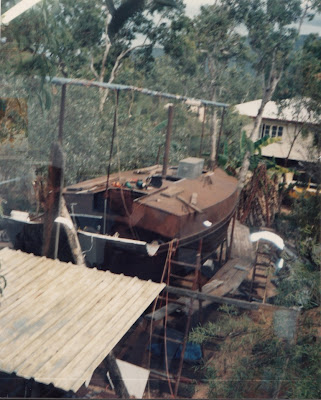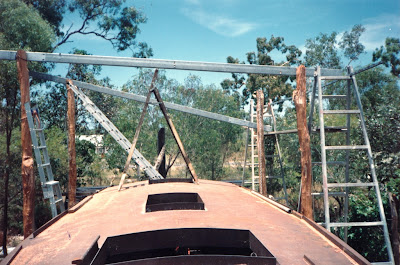Hatch holes were cut in the main deck which allowed more light and air below. The large hatches should be good in the tropics.
Then it was decision-time for the cockpit - or none. Many wylos, including the original wylo2 (pic below), have no cockpit. This allows for a broad uncluttered aft deck and an aft cabin below for a double bunk, optional stern porthole and the lazzarette which is easily accessable from inside or small port quarter deck hatch. Two fore and aft wooden toe-rails sit on the original wylo in place of a cockpit. Its easier to build too.
I took this photo aboard Nicks's Wylo2 in the Bay of Islands NZ circa 1991. The main features are the boom gallows which are incorporated into the aft rails. The dinghy davits are mounted off these. Self steering (black, vane removed) unit sits on boom gallows. The other great thing about these boom gallows is that they double as a chest height very solid aft safety rail! Something to hang onto when wrestling a big pelagic fish aboard in a big swell.
A wide skylit main hatch has fold back washboards which also functions as a fairly dry seat. The main hatch has forward end rollers and can be lifted up at the aft end over the coaming and seat down on neoprene strips glued under the hatch. (if small triangular side boards were fitted it would also form a spray dodger). Its not the usual sliding hatch design so wooden hatch guide rails are fitted to wylo2s wooden and canvas deck (entire deck area is wooden on 3'3" draft centerboard versions like wylo2 to keep the topweight down). The mainsail is loose footed and slab reefed.
I opted for the aft cockpit version, as on my plans. Talked it over with a few yachtys. No knees up around the neck, a place to toss a flapping fish or anything else to prevent it going over the side. Perhaps a recessed gas bottle box aft? The aft deck and cockpit was made from 3mm plate. A 1" stringer is fitted below the 2 ft wide cockpits centerline to stop spring. It extends to the transom and has a 1ft wide bridgedeck/beams for hull strength.
An internal view. Construction companionway step ladder in place. Note the quarter tank. It is designed for fuel but i'm going to use it as a water tank (30gal) and fit a seperate fuel tank above it later. In the keel the top of the aft keel water tank is visible (40 gals). Tempoary angles support the deck and were removed after weld up.The tempoary angles supporting the cockpit end were also later removed to allow better access.
The new shed began with paperbark poles cut from the bush out the back. Thanks to Phil for towing them over with his ute. After debarking the poles went into 4ft deep holes and were concreted in.
I added the central skylite hatch, not on the plan but fitted to many wylos. Mine is the same style as other hatches, curved with the deck camber. It seemed more aesthetic and could cut windage a little. This will be harder to make but should have extra form strength. Some wylos have flat top hatches which are easier to make, the forehatch might need to be smaller if this is used and in theory all would need to be a bit thicker than curved hatches of the same strength.
In retrospect i should have added about 12-25mm the bottom of the coamings making them 5 " wide (2" above, deck 3" below), before fitting. This would keep the internal deck head lining hidden/drier. especially if 1/2" thick slats lining is fitted.
The 4" high bulwarks were fitted and tacked on with precut drain slots on fore and aft decks. These give wylos a better sense of security than the usual 1" high toe rail would.
6m scaffold ladders were hired to fit the 6m long 6" C-beams between the poles. The extension ladders also helped. Chainsawed the tops off , notched them and augered bolt holes through. Top hat purlins, brace straps then the old roofing iron were tek screwed on. Some 4x2" crossbraces increased the cyclone rating.
It certainly was much cooler and drier in the new shed.







